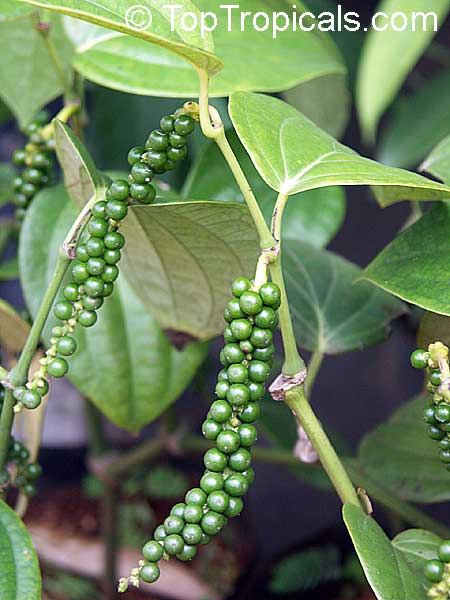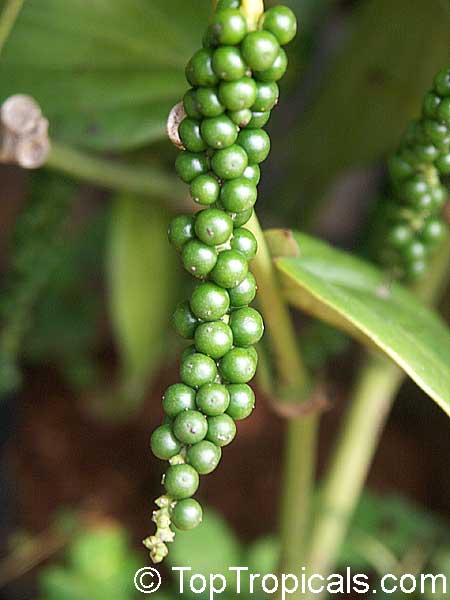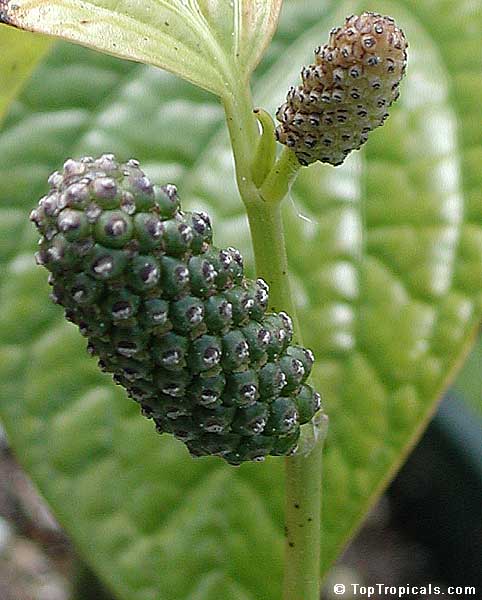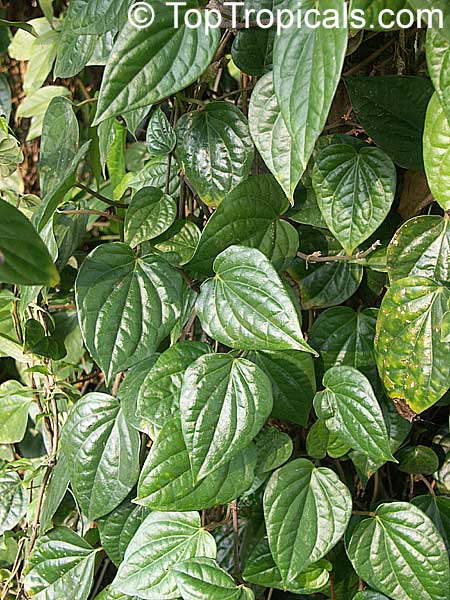Featured plant - a special for your collection
Black Pepper Vine - grow a real spice at home!
Latin name: Piper nigrum
Family: Piperaceae
Common name: Pepper, Black Pepper
Origin: Malabar, a region in the Western Coast of South India
Pepper is cultivated since millennia. Pungent and aromatic, it is grown in Southern India since more than two thousand years, has always been much valued all over the world. Along with other spices from India and lands farther east, it changed the course of world history. It was in some part the preciousness of these spices that led to the European efforts to find a sea route to India and consequently to the European colonial occupation of that country, as well as the European discovery and colonization of the Americas. Pepper was so valuable that it was often used as collateral or even currency.
Black pepper is a flowering vine cultivated for its fruit, which is dried and used as a spice and seasoning. The fruit, known as a peppercorn when dried, is a small drupe, dark red when fully mature, containing a single seed. Depending on harvest time and processing, peppercorns can be black, white, green and red (reddish-brown). So, the same fruit is also used to produce white pepper, red/pink pepper, and green pepper. While black and white pepper were already known in antiquity, but green pepper (and even more, red pepper) is a recent invention. The pungency is strongest in white pepper and weakest in green pepper, while black and green pepper are more aromatic than the white one. Green peppercorn have a somewhat immature, herbaecous fragrance. Red peppercorns combine a sugary-sweet taste with the mature pungency and flavour of black pepper.
Dried ground pepper is one of the most common spices in European cuisine and its descendants, having been known and prized since antiquity for both its flavour and its use as a medicine.
Pepper production
Black pepper is produced from the still-green unripe berries of the pepper plant. The berries are cooked briefly in hot water, both to clean them and to prepare them for drying. The heat ruptures cell walls in the fruit, speeding the work of browning enzymes during drying. The berries are dried in the sun or by machine for several days, during which the fruit around the seed shrinks and darkens into a thin, wrinkled black layer. Once dried, the fruits are called black peppercorns.
White pepper consists of the seed only, with the fruit removed. This is usually accomplished by allowing fully ripe berries to soak in water for about a week, during which the flesh of the fruit softens and decomposes. Rubbing then removes what remains of the fruit, and the naked seed is dried. Alternative processes are used for removing the outer fruit from the seed, including removal of the outer layer from black pepper produced from unripe berries.
Green pepper, like black, is made from the unripe berries. Dried green peppercorns are treated in a manner that retains the green color, such as treatment with sulphur dioxide or freeze-drying.
The Plant
The pepper plant is a spreading vine, rooting readily where trailing stems touch the ground. The flowers are small, produced on pendulous spikes four to eight centimetres long at the leaf nodes, the spikes lengthening as the fruit matures. A single stem will bear 20 to 30 fruiting spikes. The harvest begins as soon as one or two berries at the base of the spikes begin to turn red, and before the fruit is mature, but when full grown and still hard; if allowed to ripen, the berries lose pungency, and ultimately fall off and are lost.
Black pepper is grown in soil that is neither too dry nor susceptible to flooding, moist, well-drained and rich in organic matter.
The vine can be easilly grown in a pot on a trellis, 3 to 7 gal containers will be the suitable size for its successful cultivation and harvesting. In mild climates with winter temperatures above freezing, the plant can be grown in the ground providing a tree support.
Try growing this legendary plant and taste the real spice!
Some related species and their traditional uses:
Piper auritum (Root Beer Plant), also a close relative of Piper methysticum (kava-kava), grows as a bush in the South Pacific. Large-leaved perennial, known for its leaves, which are used for their spicy aromatic scent and flavor, some liken to root beer, others to anise-clove. The leaves are chopped and used for flavoring, as well as used whole, as wrappings for meats, tamales, etc. P. auritum is very often confused with Piper methysticum (kava-kava), and probably has some similar effects as a sedative, muscle relaxant, diuretic, and as a remedy for nervousness and insomnia.
Piper betle (Betel Leaf) - grows widely over the entire area between South Arabia and Southeast China as a vigorous vine with heart-shaped leaves which are marvelously pungent and spicy. Traditionally prepared by chopping or slicing the Areca nut, adding a bit of moistened lime to a Piper betle leaf and wrapping the nuts in ribbon-like strips of leaf to make a small packet known as a buyo. When one visits a household, the host will likely offer one of these buyos as a gesture of hospitality. Workers will often carry small boxes or bags of prepared betel much like the Peruvians carry coca leaves. It is used in a number of traditional remedies for the treatment of stomach ailments, infections, and as a general tonic. It is often chewed in combination with the betel nut (Areca catechu), as a stimulatory. Some evidence suggests that betel leaves have immune boosting properties as well as anti-cancer properties.
Piper sarmentosum (Chaa-plu, Vietnamese Pepper) - fast growing vine with many uses. It is used medicinally in Asia. The whole plant is used as expectorant, leaves as carminative in India and South China as well as Indonesia. It is used for feverish diseases, for digestive disorders, and toothache. When the root is chewed with betel nut, it is said to be helpful for the treatment of coughs and asthma; with nutmeg and ginger it is used to treat pleurisy. The leaves are used as food (food wraps) in Vietnam.
Order Piper Nigrum - the Pepper Vine:

The plants in stock are large and developed,
ready to fruit, with many leaves, on a trellis
Picture of the actual plant for sale,
in 1 gal container
(picture taken August 2007):






